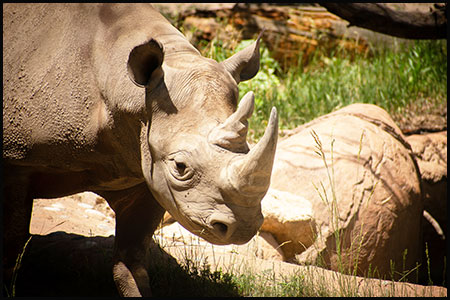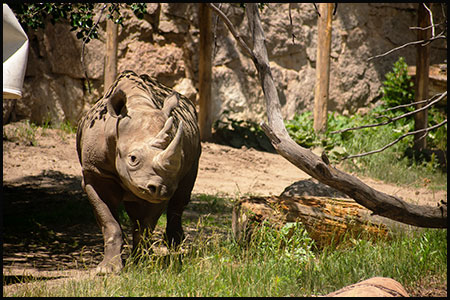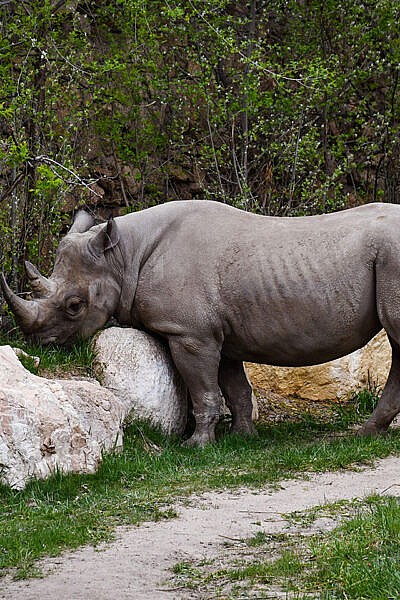Cheyenne Mountain Zoo’s 21-year-old Eastern black rhino, Jumbe, and his team are working together to address a new health concern for the 2,700-pound sweetheart. A recent routine blood test revealed iron saturation in his blood had risen to concerning levels.

Jumbe seems to be feeling well, and he isn’t showing any clinical signs of discomfort. Along with monitoring his iron metabolism status, the team is also monitoring his liver and kidney levels, among other things. All of those levels are within normal ranges.
Jumbe has surpassed the median life expectancy for his species in human care, according to the Association of Zoos and Aquariums, by two years. His team remains cautiously optimistic about his future and is exploring every avenue to help Jumbe. This condition, called iron overload disorder, can damage organs and potentially lead to fatal consequences over time.
Because black rhinos are predisposed to developing this condition, his diet was initially formulated to minimize, as much as possible, over-absorption of iron. Since the diagnosis, the care team has implemented further changes in Jumbe’s diet. The goal is to see if they can minimize iron absorption even further, based on new findings and recommendations from the Black Rhino Nutrition Advisory Group. This month, his bloodwork shows a 10 percent improvement. Despite this recent result, which is moving in the right direction, his iron levels are still high.
Iron overload disease affects around one-third of black rhinos in human care, and while there’s a lot of research underway, there are unfortunately no guaranteed remedies. The team continues to closely monitor Jumbe, conducting regular voluntary blood collection to track his progress.
“By training for these voluntary husbandry behaviors proactively and when an animal is healthy, we can better care for them when conditions like this arise,” Dr. Eric Klaphake, CMZoo head veterinarian, says. “These blood draws not only revealed an issue we needed to address, but they could also be a part of the treatment.”
Some zoos have been able to address iron overload disorder in rhinos by increasing blood draws as a treatment. By removing iron-saturated blood, new replacement red blood cells can create additional places for iron in the blood to bind to, and thereby decrease the amount of iron that would otherwise enter into tissues where it can cause damage.
“This could be an option for Jumbe, but we want to see if we can correct it without asking him to participate in more frequent and longer blood draw sessions first,” Dr. Eric says. “Of course, it would be done in volumes that are realistic for Jumbe’s well-being. This is only an option if it doesn’t reduce his quality of life, and he continues to show us he’s happy to participate in the longer blood draw sessions.”

Jumbe participates in voluntary blood draw sessions regularly with his care team, including Ilana Cobban, Encounter Africa animal care manager, CMZoo’s veterinary team and other animal keepers on his team. Jumbe and Ilana have worked together for 12 years.
“What’s wonderful about Jumbe?” Ilana says. “Everything. He has a calm and gentle demeanor that you wouldn’t typically assign to a rhino. He’s happy to stand nearby and get scratches while I talk to him, or roll around in a good mud wallow, or trot over to a fence to greet the elephants next door. He’s also a great student. He is fantastic at training, so I’m really hopeful that’s going to serve him well as we face this together.”
Dr. Eric and his team have also consulted extensively with rhino experts and researched the latest findings in animal nutrition and veterinary medicine, although finding an effective solution specific to rhinos remains challenging.
“We’re consulting with other experts, including the veterinary and nutrition advisors for the Eastern black rhino Species Survival Plan,” Dr. Eric says. “We have the best of the best on Jumbe’s case, including his care team who have built trusting relationships with Jumbe that will allow us to try new things to help him.”
Dr. Eric and his colleagues have explored various treatment options, including considering treatments for this disease in human and avian medicine, which unfortunately have not been effective in treating rhinos with this disorder.
Guests can make a direct, up-close connection with Jumbe at daily rhino feeding sessions. His distinctive pointy, prehensile top lip, a distinctive feature of Eastern black rhinos, allows him to delicately accept food offerings from visitors. At noon every day from March through October (weather – and Jumbe – permitting), guests can line up in Encounter Africa for a paid opportunity to hand-feed Jumbe. By extending his top lip to wrap it around the produce being offered, he gently accepts it – and usually leaves guests with a slobbery goodbye and a lifelong memory.
Jumbe’s snack times also help guests make a direct connection with rhino conservation. The $10 cost to participate supports CMZoo’s black rhino and African elephant conservation partner, Tsavo Trust.
As Jumbe’s health journey evolves, CMZoo will share updates.

